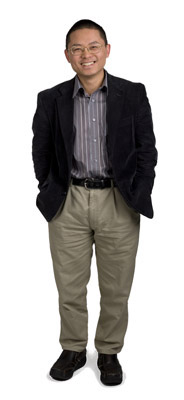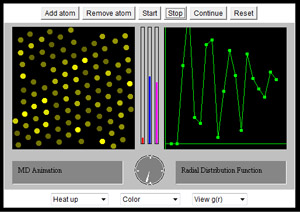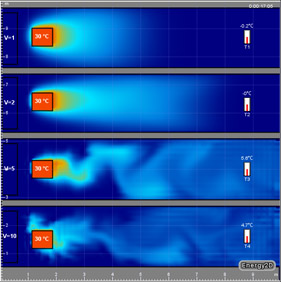 Q. What brought you to the Concord Consortium?
Q. What brought you to the Concord Consortium?
A. In 1999, I was doing my postdoc in biophysics research in Europe. At that time, Java was the hottest new programming language, and I thought that I should learn Java. So I wrote an applet, probably only 1000 lines of code total. It was a molecular dynamics simulation that was visual and ran in a web browser. I put it online, and a few months later, I got an email from Boris Berenfeld at the Concord Consortium, asking me to consult on a similar project they had just been funded to do. I replied, “Of course I’m interested, but I’m 6000 miles away. So how can I consult?”
Barbara Tinker sent me an email – I still remember the subject line – “Greetings from the Concord Consortium.” She said I could consult for the Concord Consortium and she even arranged to ship me a computer. The IBM ThinkPad was my first laptop. Customs intercepted the package and asked me to explain, so I went to customs and told them that I was a researcher at the only university on the island. Thankfully, they allowed me to take the computer. I worked on the molecular dynamics simulation, which turned into the Molecular Workbench. Getting a monthly paycheck was amazing for a poor postdoc.
Bob Tinker flew to interview me for a full-time job. We had an instant chemistry – we are both physicists. I waited until my contract the employer ended about 10 months after I first started consulting, then I got an H1B Visa to come here.
This is really a testimony to how the Internet brings people closer no matter where they are. The Internet provides opportunities that change people’s lives – it changed my career trajectory.
 The Java Molecular Dynamics applet Charles wrote in 1999.
The Java Molecular Dynamics applet Charles wrote in 1999.It still works!
Q. You developed the Molecular Workbench over the past 10 or so years. Molecular Workbench recently won the SPORE prize. What is the SPORE prize?
A. SPORE is the Science Prize for Online Resources in Education awarded by Science Magazine. Since science education is not often recognized, we are encouraged by this honor. The Molecular Workbench won the SPORE prize, but it really helps promote the entire business of learning technology for science education. Coming from Science Magazine, it has a huge impact. We appreciate their promotion of educational technology.
Q. What excites you about the future of educational technology?
A. Everybody knows the future is in the digital textbook. But I want to do something different – something that incorporates both delivery and discovery. For example, imagine that the future digital textbook is also a lab.
I am particularly interested in using science to build educational technology for STEM education. This is Concord Consortium’s trademark, though it’s somewhat uncommon for others in educational technology who do not usually go deeply into science. For instance, we see through the IR camera into the science where others just see colors. That’s a big difference. It’s also the same with regard to modeling and simulations. Many people just see animations – bouncing balls – but we see differently. In science education, our mission is to convey the profound message of science to students. So we need to invent effective technologies that can go deep. We are driven by the true needs of science education. That’s the whole point of educational reform and new standards to solve the “mile wide and inch deep” problem in our science curriculum.
Q. I hear you have a new title [IR Magician]. Tell us about that.
A. Our engineering project focuses on heat transfer, so we investigated IR technology. Infrared imaging “sees” heat and temperature, which is invisible. As soon as we purchased an IR camera, I fell in love with it. It really was love at first sight.
The IR camera is an eye-opening tool for me. The feeling of having an IR camera is similar to mastering a programming language. An IR camera gives you an IR eye that allows you to see something you don’t see with the naked eye. Just like a programming language, it empowers you to explore something you’ve never done or seen before. The reason the IR imaging is so useful is that heat and temperature is never just heat and temperature; they are always associated with underlying physical or chemical processes. Energy is just an indicator in this case. There is “IR ink” that is the trace of what has happened.
Behind an IR image, there is always something deep – for instance, a chemical reaction, phase change, or heat transfer. Naturally I looked at chemistry. I was playing with the camera and put a piece of paper on top of a cup of room-temperature water, and I was expecting to see blue color on paper. I was under the misconception that if you are near water, you will be cooler. To my surprise, the results were exactly opposite. The paper above the water was red. So what was going on?
I later realized that the red color was caused by condensation, and I was hooked on the IR camera as a tool for visualizing chemistry. This example is nontrivial because it connects so many science concepts. You have water vapor condensing to release latent heat. As more and more water condenses to the underside of the paper, those molecules have to evaporate as well. At some point, they reach dynamic equilibrium when there is no net heat release. The IR image shows the color on the paper disappear. If you remove the paper from the cup, it turns blue, because you’re breaking the dynamic equilibrium.
There’s so much science in this one experiment – condensation, evaporation, latent heat, and dynamic equilibrium. And in order for the paper to have a one- or two-degree increase in temperature, you need a thin layer that is only a few hundred molecules thick (a few dozen nanometers), which is amazing. What it is actually showing is something scientists call “atomic layer deposition.” In nanotechnology, this is the technique widely used to grow thin films and nanostructures.
As educators, our mission is to deliver this power to students and let them explore the science and discover these phenomena themselves. The experiments are so simple and easy to do, but the results appear like magic. The color changes from red to nothing to blue in just a few minutes. You can make something appear and disappear in the IR view, like magic. Unlike traditional magic on stage, you use science to achieve those affects.

An Energy2D simulation of laminar and turbulent flows.
Q. Can you describe the projects you’re currently working on?
A. I’m PI of the Engineering Energy Efficiency project, which introduces engineering into the K-12 science classroom. Students build an energy-efficient solar house. Our research question focuses on how computer simulations can enhance scientific inquiry and engineering design. We are experimenting with different strategies. In order to teach the science of heat transfer, we have created a powerful interactive, visual computational fluid dynamics tool that can show all three mechanisms of heat transfer. Energy2D can simulate heat and mass flow in real time and provide students opportunities to interact with the simulation. We use fast algorithms in computational fluid dynamics to achieve realistic effects and smooth animations. We have conducted field tests in four high schools and reached over 300 high school students. Students loved our convection simulations because the visual effect is so dramatic.
We are also developing Energy3D software, which is a design studio for students to easily create a house much faster than Google SketchUp. The system supports fabrication, so a house can be deconstructed and printed on paper from a conventional printer. Or the deconstruction can provide information about lengths and angles so students can make a larger version from the template. Eventually, we will incorporate our heat transfer simulation engine in Energy2D into Energy3D and make it wicked cool!
Our educational research will provide insights about engineering design and scientific inquiry. One possible theoretical framework we are excited about is the theory of guided design, similar to the theory of guided inquiry, which research has found to be more effective than open inquiry. We speculate that there’s a degree of similarity between guided design and guided inquiry. Performance assessment for a complex solar house design project like this is extremely difficult, but it’s a fascinating research area that we believe will have a lot of impact for engineering education, which for the first time is being written into national science standards.
I am also the PI of Electron Technologies. We are researching ways to teach abstruse, obscure concepts in nanotechnologies to two-year college students who just got out of high school and barely know anything about advanced physics or chemistry. They need to get through a two-year education and perform in a day-to-day job with scientists and engineers in the cutting-edge field of nanotechnology. So how do we as educators fill this gap? For a difficult concept like quantum tunneling, the traditional way requires a lot of math, like solving the Schrödinger equation. Few students can acquire a conceptual picture from the math, so we are exploring if computer simulations can accelerate this process or provide an alternative learning path. We are not only developing cutting-edge tools that nobody has done, we are also doing cutting-edge research. We are investigating how people learn through computer visualization about concepts that are as notoriously difficult as quantum mechanics.

A demonstration device for “taking a slice” of a temperature field. Two IR images show the results of a horizontal “slice” and a vertical “slice.”
Q. Do you have any science experiment you’re conducting in your office now?
A. I’m designing a hands-on demonstration that would allow students to separate the effects of conduction, convection, and radiation. Heat transfer cannot typically be separated – whenever there’s a heat source, conduction, convection, and radiation come together. So I’ve been working on an experiment for students to see the effects separately with the same heat source. I invented a simple “cross-section machine.” This device allows the effects of heat transfer to be projected onto a paper screen that can be arbitrarily oriented. This is like taking a “slice view” of a complicated three-dimensional temperature field. As the relative orientation of the heat source and the paper screen can be freely adjusted, this device provides ways to separate the effects of the three heat transfer mechanisms.
Q. What accomplishment are you most proud of?
A. The process of decoding the secret of science – like figuring out a computer algorithm that solves a problem, an experiment that shows an interesting effect no one has seen before, or a machine that does its job – offers many exciting moments for a scientist. I am proud that I have had many of those moments.
Q. What do you like to do outside of work?
A. I’ve figured out that jogging is the most effective way to burn calories. Since I hate the treadmill and I want to avoid traffic, I run outside on a track. I like gardening because it’s biology in my backyard. I am always amazed by how fast a plant (or weeds) can grow. And I can’t sleep without listening to classical music.